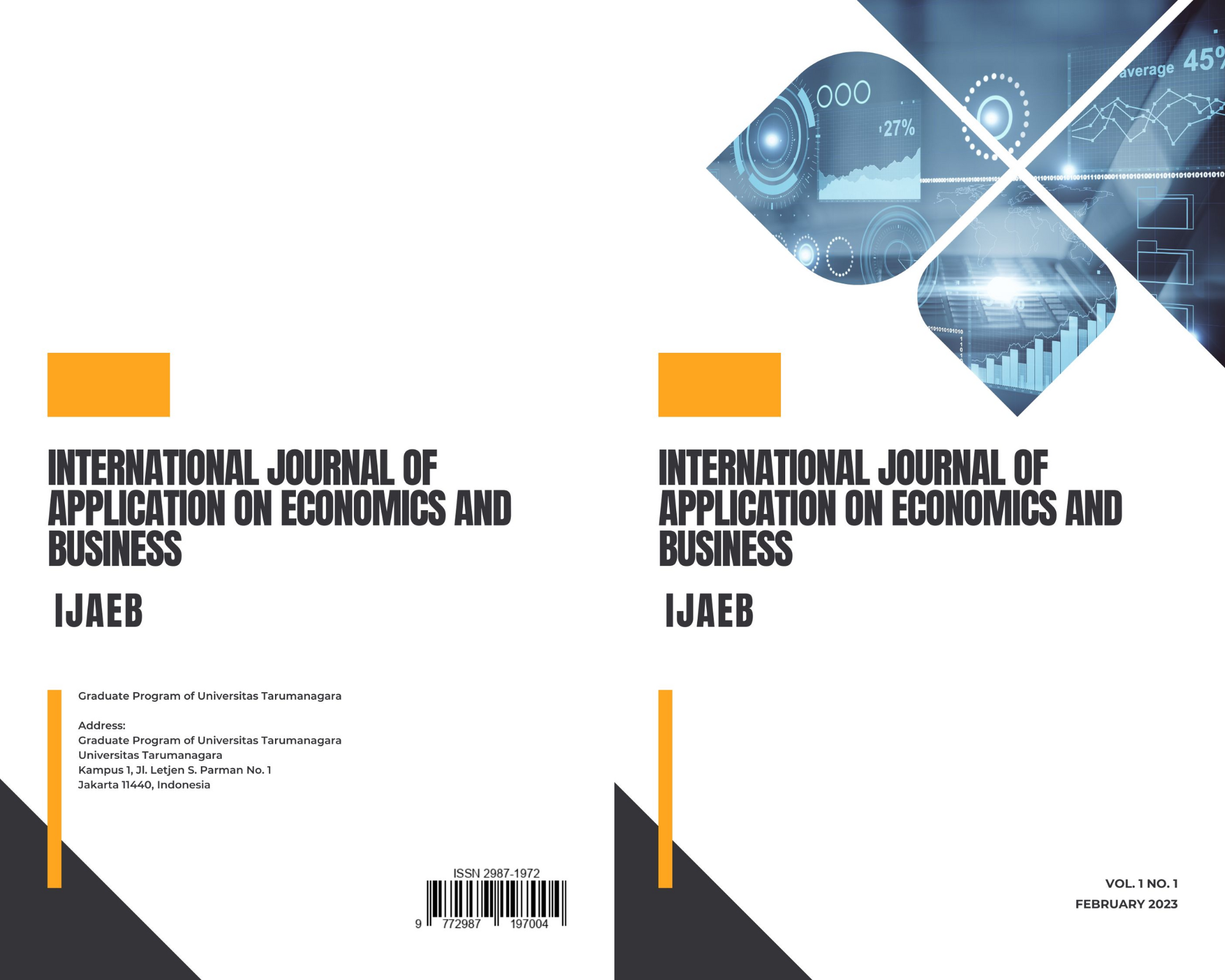The Determinants of Capital Structure for The Coal-Mining Companies Listed on Indonesia Stock Exchange
Main Article Content
Abstract
The purpose of this research is to explain the effect of profitability, asset structure, growth opportunities, and non-debt tax shields on the capital structure of the coal-mining firms indexed on the Indonesia Stock Exchange from 2016 to 2020. There are 12 company samples in this research, which was determined with the purposive sampling method. The series of tests that will be carried out in this study include descriptive statistical analysis, panel data regression model tests, classical assumption tests, multiple linear regression analysis, and hypothesis testing. The data are processed using the EViews 12 software. The outcomes of this study show that profitability (ROA) and non-debt tax shields (NDTS) are affecting the capital structure (DER) negatively and significantly, growth opportunities (MTB) is affecting the capital structure (DER) positively and significantly, while asset structure (TANG) does not affect the capital structure significantly.
Article Details

This work is licensed under a Creative Commons Attribution-NonCommercial-ShareAlike 4.0 International License.
This journal provides immediate open access to its content on the principle that making research freely available to the public supports a greater global exchange of knowledge.
IJAEB by Graduate Program of Universitas Tarumanagara is licensed under a Creative Commons Attribution-NonCommercial-ShareAlike 4.0 International License.. Permissions beyond the scope of this license may be available at https://journal.untar.ac.id/index.php/ijaeb
References
Kementerian Perindustrian Republik Indonesia, “Perjalanan Kemenperin Antarkan Transformasi Industri 4.0 di Indonesia,” 2021. https://www.kemenperin.go.id/artikel/22476/Perjalanan-Kemenperin-Antarkan-Transformasi-Industri-4.0-di-Indonesia.
M. Fitri and W. Zahar, “Kebijakan Sektor Industri Pertambangan Indonesia dalam Revolusi Industri 4.0,” Pros. TPT XXVIII Perhapi 2019, pp. 833–846, 2019.
O. Endarwati, “61 Persen Sumber Listrik RI Berasal dari Pembangkit Batu Bara,” 2021. https://www.idxchannel.com/economics/61-persen-sumber-listrik-ri-berasal-dari-pembangkit-batu-bara.
Tempo.co, “Peran Batubara Bagi Ketahanan Energi Nasional,” 2020. https://nasional.tempo.co/ read/1369151/peran-batubara-bagi-ketahanan-energi-nasional.
R. A. Brealey, S. C. Myers, and F. Allen, Principles of Corporate Finance, Twelfth Edition. McGraw Hill Education, 2015.
R. W. Melicher and E. A. Norton, Introduction to Finance, Sixteenth Edition. Wiley, 2017.
S. C. Myers, “The Capital Structure Puzzle,” J. Finance, vol. XXXIX, no. 3, pp. 575–592, 1984.
S. C. Myers, “Capital structure,” J. Econ. Perspect., vol. 15, no. 2, pp. 81–102, 2001, DOI: 10.4337/9781785363528.00012.
A. L. Handoko and S. E. Handoyo, “Pengaruh Kinerja Keuangan, Biaya Keagenan, dan Tata Kelola terhadap Kemungkinan Financial Distress,” J. Manajerial dan Kewirausahaanan, vol. 3, no. 2, pp. 287–297, 2021, doi: 10.24912/jmk.v3i2.11872.
I. Wikartika and Z. Fitriyah, “Pengujian Trade Off Theory dan Pecking Order Theory di Jakarta Islamic Index,” BISMA (Bisnis dan Manajemen), vol. 10, no. 2, pp. 90–101, 2018, doi: 10.26740/bisma.v10n2.p90-101.
E. F. Brigham and J. F. Houston, Fundamentals of Financial Management, Fifteenth Edition. Cengage Learning, 2019.
M. Alipour, M. F. S. Mohammadi, and H. Derakhshan, “Determinants of capital structure: An empirical study of firms in Iran,” Int. J. Law Manag., vol. 57, no. 1, pp. 53–83, 2015, DOI: 10.1108/IJLMA-01-2013-0004.
A. Handoo and K. Sharma, “A Study on Determinants of Capital Structure in India,” IIMB Manag. Rev., vol. 26, no. 3, pp. 170–182, 2014, doi: 10.1016/j.iimb.2014.07.009.
A. I. Dewiningrat and I. K. Mustanda, “Pengaruh Likuiditas, Profitabilitas, Pertumbuhan Penjualan, dan Struktur Aset terhadap Struktur Modal,” E-Jurnal Manaj. Unud, vol. 7, no. 7, pp. 3471–3501, 2018, doi: https://doi.org/10.24843/EJMUNUD.2018.v7.i07.p2 ISSN.
N. A. Sheikh and Z. Wang, “Determinants of Capital Structure: An Empirical Study of Firms in Manufacturing Industry of Pakistan,” Manag. Finance., vol. 37, no. 2, pp. 117–133, 2011, DOI: 10.1108/03074351111103668.
I. Widjaja and M. Leviani, “Analisis Faktor yang Mempengaruhi Struktur Modal pada Perusahaan Makanan dan Minuman yang Terdaftar di Bursa Efek Indonesia Periode 2013-2017,” J. Manaj. Bisnis dan Kewirausahaan, vol. 4, no. 1, p. 24, 2020, doi: 10.24912/jmbk.v4i1.6793.
F. J. Nugroho and E. N. A. Yuyetta, “Analisis Faktor- Faktor Yang Mempengaruhi Struktur Modal (Studi Empiris Pada Perusahaan Pertambangan Yang Listing Di BEI Tahun 2010-2013),” Diponegoro J. Account., vol. 4, no. 2, pp. 1–13, 2015.
L. Fuena and I. Widjaja, “Faktor-Faktor yang Mempengaruhi Struktur Modal pada Perusahaan Building Construction yang Terdaftar Di Bursa Efek Indonesia,” J. Manaj. Bisnis dan Kewirausahaan, vol. 5, no. 2, pp. 161–166, 2020.
J. L. Viviani, “Capital Structure Determinants: An Empirical Study of French Companies in The Wine Industry,” Int. J. Wine Bus. Res., vol. 20, no. 2, pp. 171–194, 2008, DOI: 10.1108/17511060810883786.
S. Titman and R. Wessels, “The Determinants of Capital Structure Choice,” J. Finance, vol. 43, no. 1, pp. 1–19, 1988, DOI: 10.1111/j.1540-6261.1988.tb02585.x.
J. J. Chen, “Determinants of capital structure of Chinese-listed companies,” J. Bus. Res., vol. 57, no. 12 SPEC.ISS., pp. 1341–1351, 2004, DOI: 10.1016/S0148-2963(03)00070-5.
A. Y. H. Saif-Alyousfi, R. Md-Rus, K. N. Taufil-Mohd, H. Mohd Taib, and H. K. Shahar, “Determinants of capital structure: evidence from Malaysian firms,” Asia-Pacific J. Bus. Adm., vol. 12, no. 3–4, pp. 283–326, 2020, DOI: 10.1108/APJBA-09-2019-0202.
S. G. H. Huang and F. M. Song, “The Determinants of Capital Structure: Evidence from China,” SSRN Electron. J., 2005, DOI: 10.2139/ssrn.320088.
A. K. Panda and S. Nanda, “Determinants of Capital Structure; a Sector-level Analysis for Indian Manufacturing Firms,” Int. J. Product. Perform. Manag., vol. 69, no. 5, pp. 1033–1060, 2020, DOI: 10.1108/IJPPM-12-2018-0451.
G. Gómez, A. M. Rivas, and E. R. L. Bolaños, “The Determinants of Capital Structure in Peru,” Acad. Rev. Latinoam. Adm., vol. 27, no. 3, pp. 341–354, 2014, doi: 10.1108/ARLA-01-2014-0007.
D. A. Wulandari, “Pengaruh Profitabilitas dan Non-Debt Tax Shield terhadap Struktur Modal pada Perusahaan Manufaktur Sub Sektor Farmasi yang Terdaftar di Bursa Efek Indonesia,” J. Ris. Akunt. dan Bisnis, vol. 20, no. 1, pp. 45–50, 2020, doi: 10.30596/jrab.v20i1.4871.



